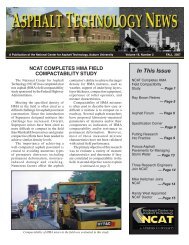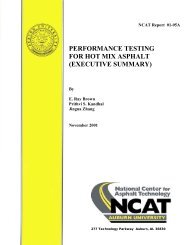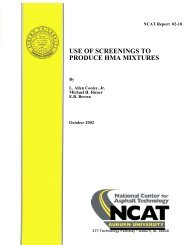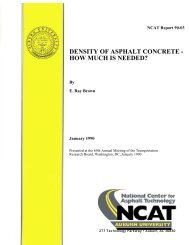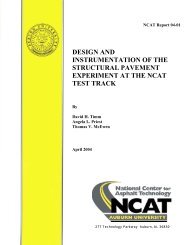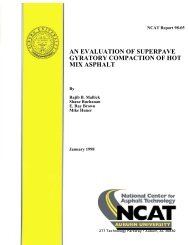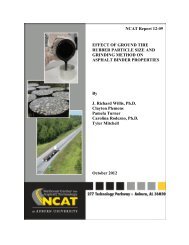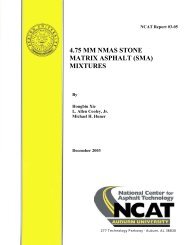A Review of Aggregate and Asphalt Mixture Specific Gravity ...
A Review of Aggregate and Asphalt Mixture Specific Gravity ...
A Review of Aggregate and Asphalt Mixture Specific Gravity ...
Create successful ePaper yourself
Turn your PDF publications into a flip-book with our unique Google optimized e-Paper software.
TABLE 3 Advantages <strong>and</strong> Disadvantages <strong>of</strong> Alternative Methods forDetermining G sb <strong>of</strong> Coarse <strong>Aggregate</strong>AASHTOMethod <strong>and</strong>/or ASTM AdvantagesDisadvantagesDesignationAggPlus /None SSD weight not required More complicated to runCoreLok Result in 30 minutes More expensive than theSystem or Long soaking period not st<strong>and</strong>ard methods due toVacuum-Sealrequiredequipment <strong>and</strong> bag costsMethod Slightly more repeatable More effort to improve(Instrotek) Use for both coarse <strong>and</strong> reproducibility neededfine aggregateRapid WaterDisplacement(Gilson)None SSD weight not required Equipment beingdeveloped; no researchavailable at this timeThe two alternative methods shown in Table 3 are expected to address theshortcomings <strong>of</strong> the current st<strong>and</strong>ard test methods. A number <strong>of</strong> investigators haveattempted to evaluate the AggPlus system against the current AASHTO method fordetermining the specific gravity <strong>and</strong> absorption <strong>of</strong> coarse aggregate. For the Gilson RapidWater Displacement method, equipment is currently being developed, so no comparisonis available at this time. However, the AggPlus/CoreLok system or vacuum-seal methodhas been studied by several researchers. The objectives <strong>of</strong> these studies were to evaluatethe reproducibility <strong>of</strong> the AggPlus system <strong>and</strong> to determine if it would produce resultsthat are statistically different from those produced by the current st<strong>and</strong>ard test methods.In 2004, Hall (4) measured bulk specific gravity <strong>of</strong> six coarse aggregates fromvarious mineralogy sources in Arkansas using the AASHTO T 85 <strong>and</strong> vacuum-seal(CoreLok) method. To minimize sources <strong>of</strong> variability, one operator conducted all testing<strong>of</strong> five replicates for each aggregate using both test methods. Hall reported that G sb valuesdetermined using the two test procedures were significantly different. The AggPlussystem tended to produce higher G sb values for coarse aggregate with absorptions <strong>of</strong> morethan one percent regardless <strong>of</strong> mineralogy. More effort was recommended to improve thetest consistency <strong>and</strong> produce test results comparable to those resulting from the st<strong>and</strong>ardtest methods if the results are to be used for specification purposes.In 2005, Mgonella (5) evaluated the AggPlus system against the AASHTO T 85method using eight coarse aggregates representing four basic aggregate types inOklahoma. The tests were performed by two operators to determine the interactionbetween the test methods <strong>and</strong> operators. Mgonella reported that G sb values determinedusing the two methods were statistically different. The AggPlus system produced higherG sb values. No interactions between G sb values <strong>and</strong> operators were found for either testmethod. The AggPlus system <strong>and</strong> the AASHTO T 85 method had similar reproducibility.The research did not recommend the alternative procedure for replacement <strong>of</strong> the currentAASHTO T 85 method.5




